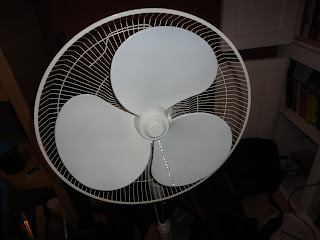Got a bit of time this evening to test out the LED array I made yesterday for the Build Brighton message fan..
The thin wire-wrapping wires are soldered to a scrap of veroboard for test connections , and the code is running on a PIC16F688. The shift regs are wired to share common clock lines, but each has its own serial data line, so all LED data can be loaded in 8 clock pulses so refresh should be nice and fast in the final thing.
Everything seemed to work first time, amazingly! These water clear RGB LEDs are nice and bright, but its possible to see the individual red/green/blue elements more than you would in a diffused LED (e.g. when you display yellow you can see the red and green elements rather than a single yellow point). I'm hopeful this won't be a problem when the thing is spinning and viewed from a distance.
My 100 ohm series resistance is rather low when the LEDs are run continuously but in the past I've found a low-ish resistance like this to be good when pulsing the LEDs quickly in a POV display. Still - I'll have to try to make sure the LEDs dont get left on 100% duty for a long time just in case they don't like the current.
I also mounted the board to the fan! With the help of some heavy duty double sided tape (for sticking carpets down) and cyanoacrylate superglue to hold the LEDs in the holes it seems to be pretty sturdy... famous last words...
Next step is to build a microcontroller board small enough to fit into the hub of the fan, then we (me and the Rev's Neil and Dave from BuildBrighton) need to get it power (via a pair of coils) and data (hopefully a modulated signal riding on the power)... and so the fun will really start!







